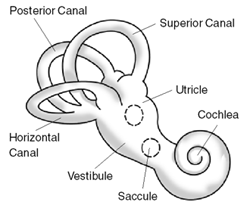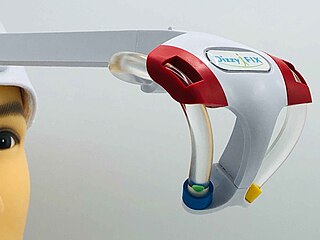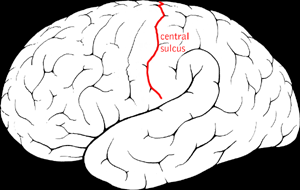Related Research Articles

Alice in Wonderland syndrome (AIWS), also known as Todd's syndrome or dysmetropsia, is a neuropsychological condition that causes a distortion of perception. People may experience distortions in visual perception of objects such as appearing smaller (micropsia) or larger (macropsia), or appearing to be closer (pelopsia) or farther (teleopsia) away than they actually are. Distortion may occur for other senses besides vision as well.
Macropsia is a neurological condition affecting human visual perception, in which objects within an affected section of the visual field appear larger than normal, causing the person to feel smaller than they actually are. Macropsia, along with its opposite condition, micropsia, can be categorized under dysmetropsia. Macropsia is related to other conditions dealing with visual perception, such as aniseikonia and Alice in Wonderland Syndrome. Macropsia has a wide range of causes, from prescription and illicit drugs, to migraines and (rarely) complex partial epilepsy, and to different retinal conditions, such as epiretinal membrane. Physiologically, retinal macropsia results from the compression of cones in the eye. It is the compression of receptor distribution that results in greater stimulation and thus a larger perceived image of an object.
Growing pains are recurring pain symptoms that are relatively common in children ages 3 to 12. The pains normally appear at night and affect the calf or thigh muscles of both legs. The pain stops on its own before morning.
A headache is often present in patients suffering from epilepsy. If the headache occurs in the vicinity of a seizure, it is defined as peri-ictal headache, which can occur either before (pre-ictal) or after (post-ictal) the seizure, to which the term ictal refers. An ictal headache itself may or may not be an epileptic manifestation. In the first case it is defined as ictal epileptic headache or simply epileptic headache. It is a real painful seizure, that can remain isolated or be followed by other manifestations of the seizure. On the other hand, the ictal non-epileptic headache is a headache that occurs during a seizure but it is not due to an epileptic mechanism. When the headache does not occur in the vicinity of a seizure it is defined as inter-ictal headache. In this case it is a disorder autonomous from epilepsy, that is a comorbidity.

Benign paroxysmal positional vertigo (BPPV) is a disorder arising from a problem in the inner ear. Symptoms are repeated, brief periods of vertigo with movement, characterized by a spinning sensation upon changes in the position of the head. This can occur with turning in bed or changing position. Each episode of vertigo typically lasts less than one minute. Nausea is commonly associated. BPPV is one of the most common causes of vertigo.
Non-epileptic seizures (NES), also known as non-epileptic events, are paroxysmal events that appear similar to an epileptic seizure but do not involve abnormal, rhythmic discharges of neurons in the brain. Symptoms may include shaking, loss of consciousness, and loss of bladder control.

Vertigo is a condition where a person has the sensation of moving or of surrounding objects moving when they are not. Often it feels like a spinning or swaying movement. This may be associated with nausea, vomiting, sweating, or difficulties walking. It is typically worse when the head is moved. Vertigo is the most common type of dizziness.
The Dix–Hallpike test — or Nylén–Bárány test — is a diagnostic maneuver used to identify benign paroxysmal positional vertigo (BPPV).
Alternating hemiplegia of childhood is an ultra-rare neurological disorder named for the transient episodes, often referred to as "attacks", of hemiplegia from which those with the disorder suffer. It typically presents before the age of 18 months. These hemiplegic attacks can cause anything from mild weakness to complete paralysis on one or both sides of the body, and they can vary greatly in duration. Attacks may also alternate from one side of the body to the other, or alternate between affecting one or both sides during a single attack. Besides hemiplegia, symptoms of the disorder include an extremely broad range of neurological and developmental impairments which are not well understood. Normally, hemiplegia and other associated symptoms cease completely with sleep, but they may recur upon waking.

The DizzyFIX is an FDA-cleared home medical device available to assist in the treatment of benign paroxysmal positional vertigo (BPPV) and its associated vertigo. The device itself is a head-worn representation of semi-circular canals. The device is filled with fluid and a particle representing the otoconia associated with BPPV. The device works like a visual set of instructions and guides the user through the treatment maneuver for BPPV. This maneuver is called the particle repositioning maneuver or Epley maneuver.
The Epley maneuver or repositioning maneuver is a maneuver used by medical professionals to treat one common cause of vertigo, benign paroxysmal positional vertigo (BPPV) of the posterior or anterior canals of the ear. The maneuver works by allowing free-floating particles, displaced otoconia, from the affected semicircular canal to be relocated by using gravity, back into the utricle, where they can no longer stimulate the cupula, therefore relieving the patient of bothersome vertigo. The maneuver was developed by the physician, John M. Epley, and was first described in 1980.

Nystagmus is a condition of involuntary eye movement, acquired in infancy or later in life, that may result in reduced or limited vision. Due to the involuntary movement of the eye, it has been called "dancing eyes".

Benign Rolandic epilepsy or benign childhood epilepsy with centrotemporal spikes (BCECTS) is the most common epilepsy syndrome in childhood. Most children will outgrow the syndrome, hence the label benign. The seizures, sometimes referred to as sylvian seizures, start around the central sulcus of the brain.

Paroxysmal exercise-induced dystonia or PED is a rare neurological disorder characterized by sudden, transient, involuntary movements, often including repetitive twisting motions and painful posturing triggered by exercise or other physical exertion. PED is in the class of paroxysmal dyskinesia which are a group of rare movement disorders characterized by attacks of hyperkinesia with intact consciousness. The term paroxysmal indicates that the episodes are sudden and short lived and usually unpredicted, and return to normal is rapid. The number of reported cases of people with PED is very small leading to difficulty in studying and classifying this disease and most studies are limited to a very small number of test subjects.
Panayiotopoulos syndrome is a common idiopathic childhood-related seizure disorder that occurs exclusively in otherwise normal children and manifests mainly with autonomic epileptic seizures and autonomic status epilepticus. An expert consensus has defined Panayiotopoulos syndrome as "a benign age-related focal seizure disorder occurring in early and mid-childhood. It is characterized by seizures, often prolonged, with predominantly autonomic symptoms, and by an EEG [electroencephalogram] that shows shifting and/or multiple foci, often with occipital predominance."
Vestibular migraine (VM) is vertigo associated with a migraine, either as a symptom of migraine or as a related but neurological disorder, when referred to as a disease unto itself.
Benign paroxysmal torticollis (BPT) is a rare medical disorder affecting infants.
Idiopathic childhood occipital epilepsy of Gastaut (ICOE-G) is a pure but rare form of idiopathic occipital epilepsy that affects otherwise normal children and adolescents. It is classified amongst benign idiopathic childhood focal epilepsies such as rolandic epilepsy and Panayiotopoulos syndrome.
Paroxysmal tonic upgaze (PTU) of childhood is a rare and distinctive neuro-ophthalmological syndrome characterized by episodes of sustained upward deviation of the eyes. Symptoms normally appear in babies under one year of age and are characterized by an upward stare or gaze, with the eyes rolled back, while the chin is typically held low.

Occipital epilepsy is a neurological disorder that arises from excessive neural activity in the occipital lobe of the brain that may or may not be symptomatic. Occipital lobe epilepsy is fairly rare, and may sometimes be misdiagnosed as migraine when symptomatic. Epileptic seizures are the result of synchronized neural activity that is excessive, and may stem from a failure of inhibitory neurons to regulate properly.
References
- ↑ Batson, G (Jan 2004). "Benign paroxysmal vertigo of childhood: A review of the literature". Paediatrics & Child Health. 9 (1): 31–4. doi:10.1093/pch/9.1.31. PMC 2719513 . PMID 19654978.